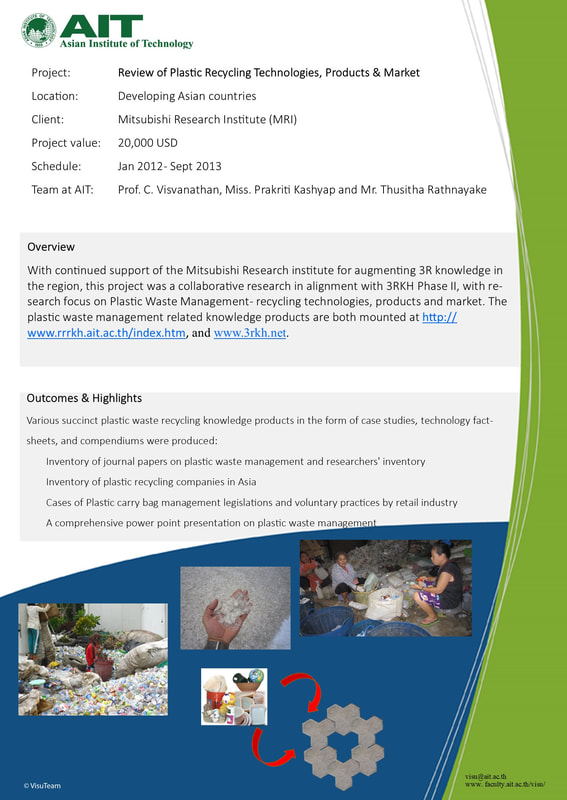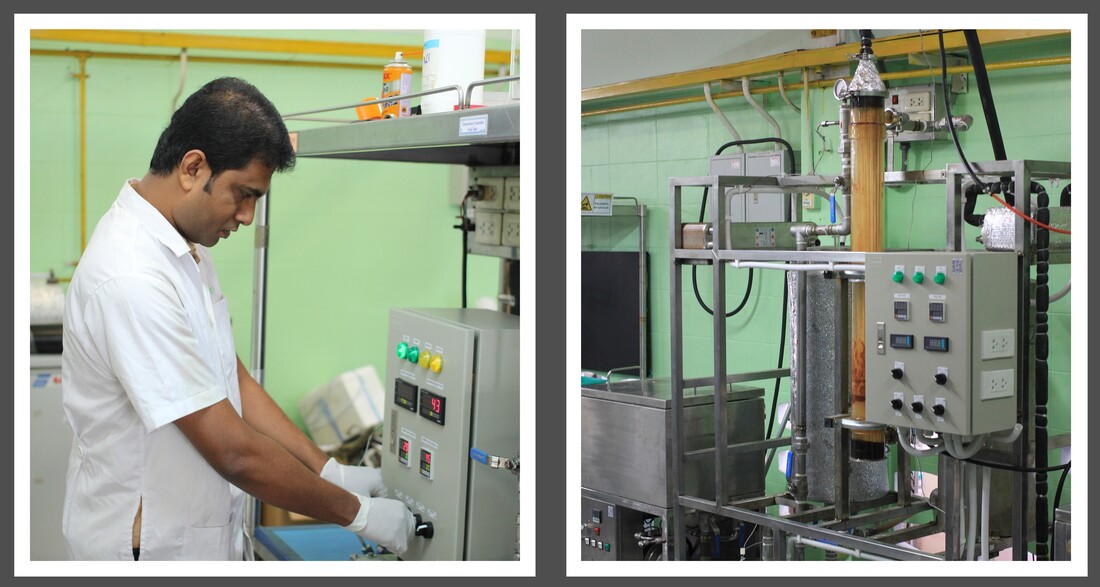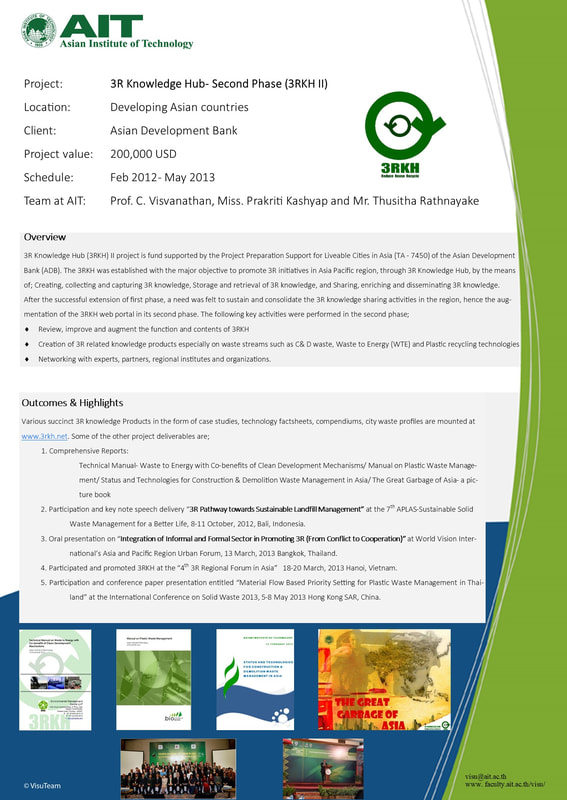Project Experience
Highlighted Projects
Community scale, decentralized anaerobic digestion for energy and resource recovery, funded by the British Council (AIT-LU-Newton Fund Project)
|
Project Description:
This project has done under the collaboration of Loughborough University (LU). The project aimed to create a decentralized anaerobic digester which can be remotely monitored and controlled. One of the objectives was to create a business model to commercialize the technology in the rural part of Thailand, where the consumers will be benefitted by the recovered energy and resources from a community scale anaerobic digester. Project Sponsor- British Council: Newton Institutional Link Grants (£250,000) Link |
|
Treatment of Wastewater using Pilot Scale Membrane Aerated Biofilm Reactor (MABR) for the Removal of Organic Matter and Total Nitrogen, funded by Mitsubishi Chemical Aqua Solutions Co. Ltd, Japan
Project Description:
Membrane Aerated Biofilm Reactors (MABR) are a recently developed biofilm technology, which provides effective simultaneous nitrification and de-nitrification in the same reactors. In this study, performances of two pilot-scale MABR systems with MHF-300EPE membranes of different relaxation rates are compared to treating domestic wastewater with and without PVA gel bio-carriers for the removal of organic matters and total nitrogen.
Membrane Aerated Biofilm Reactors (MABR) are a recently developed biofilm technology, which provides effective simultaneous nitrification and de-nitrification in the same reactors. In this study, performances of two pilot-scale MABR systems with MHF-300EPE membranes of different relaxation rates are compared to treating domestic wastewater with and without PVA gel bio-carriers for the removal of organic matters and total nitrogen.
Review of Plastic Recycling Technologies, Products & Market
|
Project Description:
With continued support of the Mitsubishi Research institute for augmenting 3R knowledge in the region, this project was a collaborative research in alignment with 3RKH Phase II, with research focus on Plastic Waste Management- recycling technologies, products, and market. The plastic waste management related knowledge products are both mounted at, http://www.rrrkh.ait.ac.th/index.htm, and www.3rkh.net. |
Evaluating the Performance of Membrane Aerated Biofilm Reactor (MABR) Membrane Modules, funded by Mitsubishi Chemical Aqua Solutions Co. Ltd, Japan
Project Description:
Different technologies have been developed in recent times for wastewater treatment and among them, the current technologies are focused on membrane aerated biofilm reactors. However, several factors play significant roles in performance of the reactor system. Thus, it is a prime area of concern for manufacturers and scholars to research different parameters that can increase their efficiency. For this purpose, this research is aimed for feasibility study on joint research and development with respect to MABR using Mitsubishi's Multi-layered Hollow Fiber membrane and analyze its performance based on Oxygen Transfer Rates and removal of nitrogen and COD in lab scale and pilot scale modules as its application.
Different technologies have been developed in recent times for wastewater treatment and among them, the current technologies are focused on membrane aerated biofilm reactors. However, several factors play significant roles in performance of the reactor system. Thus, it is a prime area of concern for manufacturers and scholars to research different parameters that can increase their efficiency. For this purpose, this research is aimed for feasibility study on joint research and development with respect to MABR using Mitsubishi's Multi-layered Hollow Fiber membrane and analyze its performance based on Oxygen Transfer Rates and removal of nitrogen and COD in lab scale and pilot scale modules as its application.
Development of water treatment equipment for high-rate sedimentation, filtration system suitable for Thailand water quality characteristics, funded by NoxKorea, Co. Korea
Project Description:
The project aims to develop high-rate sedimentation-filtration system in the water treatment plant which is suitable for southeastern countries regard to producing safe drinking water with low price and stable operation by automating. This system applied to PWA waterworks under the support of NoxKorea and monitored by the AIT research team.
The project aims to develop high-rate sedimentation-filtration system in the water treatment plant which is suitable for southeastern countries regard to producing safe drinking water with low price and stable operation by automating. This system applied to PWA waterworks under the support of NoxKorea and monitored by the AIT research team.
Characterization of Municipal Solid Waste in Phetchaburi Province, Thailand
|
Project Description:
The research was conducted to provide composition and characteristics of municipal solid waste in Phetchaburi province, Thailand as the client Phetchaburi Green Energy Co.Ltd. is exploring the feasibility of waste to energy generation project in the province. As waste characterization plays an important role in choosing the appropriate waste recovery technology and designing the scale of operation/project, the report provided to the client is expected to assist the decision-making on the proposed waste to energy project activities. |
Applications of Membrane Bio Reactor (MBR) and Membrane Distillation (MD) technologies in water treatment, funded by Sumitomo Electric Industries, Ltd. Japan
Project Description:
This project has focused to develop a thermophilic anaerobic membrane bioreactor (TAnMBR) by using PTFE membrane for palm oil wastewater treatment and biogas production. This research work consisted with two major objectives, which were: Investigate and develop a TAnMBR by using PTFE membrane for palm oil wastewater treatment, biogas production and investigate the possibility of concentrating the oil in palm oil wastewater.
Publication
This project has focused to develop a thermophilic anaerobic membrane bioreactor (TAnMBR) by using PTFE membrane for palm oil wastewater treatment and biogas production. This research work consisted with two major objectives, which were: Investigate and develop a TAnMBR by using PTFE membrane for palm oil wastewater treatment, biogas production and investigate the possibility of concentrating the oil in palm oil wastewater.
Publication
Reports on drinking water services and technologies, funded by Japan Water Research Center (JWRC).
Project Description:
This project was a part of an agreement between Japan Water Research Center (JWRC) and Asian Institute of Technology (AIT) to highlight various water supply/treatment projects in Asia that have been funded by international donors such as JICA, ADB, World Bank and so on. As such, technical and financial components of such projects have investigated, and their impacts described in brief. The information has disseminated through a separate website dedicated to this project.
Link
This project was a part of an agreement between Japan Water Research Center (JWRC) and Asian Institute of Technology (AIT) to highlight various water supply/treatment projects in Asia that have been funded by international donors such as JICA, ADB, World Bank and so on. As such, technical and financial components of such projects have investigated, and their impacts described in brief. The information has disseminated through a separate website dedicated to this project.
Link
Development of a membrane-based treatment of TEG for gas separation plant’s wastewater, funded by Petroleum Authority of Thailand (PTT)
Project Description:
The main objectives of the work carried out under this proposal was to separate and treat TEG (Triethylene glycol) infested wastewater from PTT’s Gas Separation Plant exploring possibilities with a membrane-based solution. The overall work that carried out were namely: 1) Intensive literature review on TEG removal by membrane technologies, especially for membrane distillation, pervaporation, nanofiltration and reverse osmosis. 2) Investigate the efficiency of TEG removal from synthetic wastewater using various bench scale membrane technologies like nano filtration, reverses osmosis and pervaporation as well as explore the possibility and limitation for TEG separation and concentration from the real wastewater. 3) Set up a semi-pilot scale plant for evaluation of TEG removal from the waste stream and study the operating conditions.
The main objectives of the work carried out under this proposal was to separate and treat TEG (Triethylene glycol) infested wastewater from PTT’s Gas Separation Plant exploring possibilities with a membrane-based solution. The overall work that carried out were namely: 1) Intensive literature review on TEG removal by membrane technologies, especially for membrane distillation, pervaporation, nanofiltration and reverse osmosis. 2) Investigate the efficiency of TEG removal from synthetic wastewater using various bench scale membrane technologies like nano filtration, reverses osmosis and pervaporation as well as explore the possibility and limitation for TEG separation and concentration from the real wastewater. 3) Set up a semi-pilot scale plant for evaluation of TEG removal from the waste stream and study the operating conditions.
Ceramic membrane filtration pilot unit at Bangkhen water treatment plant, funded by University of Tokyo, Japan
|
Project Description:
Ceramic membrane filtration has emerged as a viable drinking water treatment alternative to comply with existing water quality regulations. Natural Organic Matter (NOM) fouling is one of the main drawbacks in filtration processes for water treatment in tropical climate. NOM in drinking water source is a primary concern because it acts as a precursor in the formation of potentially harmful disinfection by - products. The study has been conducted to analyze the NOM fouling and NOM removal, and the removal of pathogenic parameters though ceramic membrane filtration. The ceramic membrane filtration system has operated under highly turbid raw conditions at the Bangkhen Water Treatment Plant. |
Sustainable water management in urban fringe areas through industrial wastewater reuse, project sponsored by the French Ministry of Foreign and European Affairs
Project Description:
Wastewater reuse has become increasingly important in water resource management for both environmental and economic reasons. The project has investigated the treatability of industrial effluents with membrane technology for reuse applications. Treated water quality and purpose of reuse application were evaluated with the different types of technological and strategic applications.
Wastewater reuse has become increasingly important in water resource management for both environmental and economic reasons. The project has investigated the treatability of industrial effluents with membrane technology for reuse applications. Treated water quality and purpose of reuse application were evaluated with the different types of technological and strategic applications.
3R Knowledge Hub (3RKH), Phase II, funded by Asian Development Bank (ADB)
|
Project Description:
3R Knowledge Hub (3RKH) II project is fund supported by the “Project Preparation Support for Livable Cities in Asia (TA - 7450)” of the Asian Development Bank (ADB). The 3RKH was established with the major objective to promote 3R initiatives in Asia Pacific region, through the 3R Knowledge Hub, by the means of; Creating, collecting and capturing 3R knowledge, Storage and retrieval of 3R knowledge, and Sharing, enriching and disseminating 3R knowledge. |





